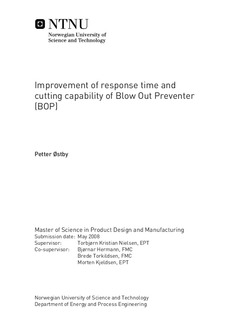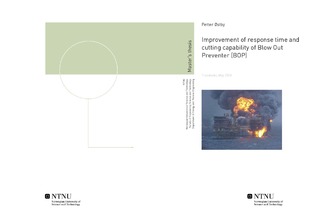| dc.contributor.advisor | Nielsen, Torbjørn Kristian | |
| dc.contributor.advisor | Hermann, Bjørnar | |
| dc.contributor.advisor | Torkildsen, Brede | |
| dc.contributor.advisor | Kjeldsen, Morten | |
| dc.contributor.author | Østby, Petter | |
| dc.date.accessioned | 2015-10-10T14:00:42Z | |
| dc.date.available | 2015-10-10T14:00:42Z | |
| dc.date.created | 2008-05-30 | |
| dc.date.issued | 2008 | |
| dc.identifier | ntnudaim:4282 | |
| dc.identifier.uri | http://hdl.handle.net/11250/2353739 | |
| dc.description.abstract | There is a general demand in the market for BlowOut Preventers (BOP), which are
capable of cutting tougher materials and cutting them faster than what is available
today. This will give better safety and a more efficient use of the equipment. Better
cutting capabilities are directly related to the pressures available to the cutting actuator.
Normal accumulators loose pressure while it is drained. To avoid this a gas tank with
high pressure nitrogen is proposed to boost the pressures during the cutting operation.
A boost tank will however contain pressures which are much higher then the allowed
pressure in the BOP circuit. It is therefore necessary with a governor which controls
the pressure. Normal pressure regulating valves tend to have difficulties maintaining a
constant pressure while the pressure in the boost tank drops. Therefore is a PI-governor
proposed, which may increase the stability and reliability of the BOP.
This report focuses mainly on the design of the PI-governor and how to optimize its
design and parameters. The results are promising and the solution shows a more stable
pressure than both the old accumulator solution and normal pressure regulating valves.
There are however a few flaws with the design. First; may even very small leakages
and changes in material properties severely reduce and/or destroy the efficiency of the
governor. Small leakages may quickly increase the system pressures and empty the
boost tank. Another problem is the overlap in normal proportional directional valves.
This severely reduces the efficiency of the integrator in the governor.
A mechanism for refilling the boost tank using a high pressure supply line from the
rig is found to work quite well in simulations. The nitrogen gas is pushed back into
the boost tank and the system is reset. | |
| dc.language | eng | |
| dc.publisher | NTNU | |
| dc.subject | Produktutvikling og produksjon, Energi-, prosess- og strømningsteknikk | |
| dc.title | Improvement of response time and cutting capability of Blow Out Preventer (BOP) | |
| dc.type | Master thesis | |
| dc.source.pagenumber | 97 | |

